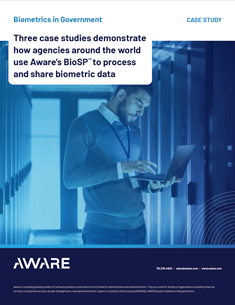 A civil ABIS (automated biometric identification system) stores and searches biometric data enrolled from a civilian population for applications such as citizen credentialing and border management. Its purpose is to compare one biometric sample (e.g. fingerprint, face, or iris) to those of everyone else in one or more databases in order to retrieve that record in the database. In this way, the claimed identity of the individual can be confirmed, their presence in a watch list can be detected, and duplicate identities can be prevented. An ABIS differs from an “AFIS” in that is can handle biometric modalities beyond fingerprints.
A civil ABIS (automated biometric identification system) stores and searches biometric data enrolled from a civilian population for applications such as citizen credentialing and border management. Its purpose is to compare one biometric sample (e.g. fingerprint, face, or iris) to those of everyone else in one or more databases in order to retrieve that record in the database. In this way, the claimed identity of the individual can be confirmed, their presence in a watch list can be detected, and duplicate identities can be prevented. An ABIS differs from an “AFIS” in that is can handle biometric modalities beyond fingerprints.
This “one-to-many” search is different than “one-to-one” biometric authentication; if someone else scans their face on your smartphone to authenticate, biometric algorithms determine that it is not you and denies access. But this type of biometric match will not tell you who that “someone else” is.
The difference between civil and criminal ABIS: latents
Civil and criminal ABIS are similar in that they both utilize one-to-many, multimodal biometric search, but apply them for very different purposes. The primary differentiating feature of a criminal ABIS is its ability to include “latent” fingerprints in searches. Latent fingerprints are those left behind at a crime scene, and are generally of much lower quality and content than those collected directly from an individual.
Because of their low quality, there is typically a need for the participation of a professional “latent examiner” to aid a biometric search involving latents. So a criminal ABIS includes algorithms specifically designed to perform comparisons between latent images, as well as tools for latent examiners to aid their work.
Another important feature of criminal ABIS is that their search results are often used to help prosecute a crime in a court of law. So a criminal ABIS ideally includes tools for documenting the process and results of a search that are useful to that end.
Beyond fingerprints, there is an analogy with facial images, where algorithms are similarly optimized for low-quality images (e.g. from surveillance) and tools for a professional examiner to aid a search.
Perhaps the best known criminal ABIS is the FBI’s “IAFIS”. It is among the largest in the world. An important feature of this ABIS is that it operates as a service for parties outside the FBI to be able to submit biometric data for enrollment and search. This includes other government agencies, state and local law enforcement, and international organizations law enforcement organizations.
The benefits of civil ABIS
The main benefit of civil ABIS is its ability to flag instances of intentional misidentification. An individual with an existing identity, for instance, may attempt to enroll under a new alias. Collecting a biometric sample at the time of enrollment would trigger a match if the identity is already enrolled.
The same applies for someone attempting to steal another person’s identity. Upon submitting a biometric sample to the ABIS, the fraudster’s true identity would be uncovered, and the attempt to enroll as someone else would be thwarted.
Use cases for civil ABIS
Accurate identification is civil ABIS’s core competency, which makes it invaluable for a number of use cases:
Citizens benefits programs
Citizens attempting to enroll in public benefits programs such as state-sponsored healthcare can verify their identity through a biometric search. This helps prevent fraudulent attempts to participate in citizens benefits programs.
Voting systems
While virtually non-existent in Europe and the U.S., nearly half of all countries in Africa use fingerprints or facial images in voter registration, according to the Institute for Democracy and Electoral Assistance. The benefit of a biometric-based voting system, besides the ability to help prevent voter fraud, is that it creates a very accessible standard for voter ID. Not everyone has a driver’s license or passport, but most people have a face or a fingerprint that they can use to register.
Citizen credentials
A civil ABIS can detect attempts to fraudulently procure an identity document such as a passport, a driver’s license, or a national ID using fake or stolen biographic information (name, date of birth, a doctored birth certificate, address, etc.). During the attempted registration, a civil ABIS can search a biometric sample against existing biometric templates to find out if that person is already enrolled under another identity. This prevents the issuance of a legitimate document to a false identity.
Other credentials that biometrics can help protect include:
- Gun licenses
- Civil servant IDs
- Armed forces IDs
- Seafarers cards
Border management
Some countries require foreign visitors applying for certain visas, permits, or residency statuses to provide a biometric sample. Starting Dec. 31, 2018, Canada will require applicants for temporary resident visas, work permits, study permits, temporary resident permits, and permanent residence to submit fingerprints and digital photograph.
This biometric data can be cross-referenced against watchlists, immigration records, and criminal databases. This helps the Canada Border Services Agency identify applicants with prior immigration infractions or criminal pasts that might influence their eligibility to enter the country.
Learn more about AwareABIS
Civil ABIS can match fingerprint, face, and iris samples to large-scale existing biometric templates with incredible accuracy. It can also handle high volumes per second.
Additionally, biometrics are more reliable than biographic data as unique identifiers because they’re much harder to steal and use for fraud.
To learn more about the benefits of civil ABIS, contact Aware today, or explore our Citizen ID solutions.
